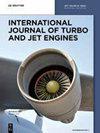Influences of unbalance phase combination on the dynamic characteristics for a turboprop engine
IF 0.9
4区 工程技术
Q4 ENGINEERING, AEROSPACE
引用次数: 0
Abstract
Abstract To reduce excessive vibration of a turboprop engine with qualified balanced compressor and turbine rotor, the finite element model of the rotor system was established. The magnitude, axial distribution and especially the phase combinations of the residual unbalances were considered and optimized. Based on the numerical results, the whole engine tests were conducted for verification. The numerical and experimental results show that the vibration level of the rotor system can be significantly reduced by only changing the phase combination of the residual unbalances. The magnitude, axial distribution of residual unbalance and rotational speed of the rotor play a very important role in determining the optimal phase combination. The optimal phase combination under different rotational speeds might be conflicting, and reasonably designed optimization would be a feasible solution. The findings of the research can provide important reference for the design and troubleshooting for similar industrial turbine engines.不平衡相组合对涡桨发动机动力特性的影响
摘要为了降低涡轮螺旋桨发动机的过度振动,建立了转子系统的有限元模型。对残余不平衡的大小、轴向分布,特别是相位组合进行了考虑和优化。根据数值计算结果,对发动机进行了整机试验验证。数值和实验结果表明,只需改变残余不平衡的相位组合,就能显著降低转子系统的振动水平。剩余不平衡量的大小、轴向分布和转子转速对确定最佳相位组合起着非常重要的作用。不同转速下的最佳相位组合可能存在冲突,合理设计的优化方案是可行的。研究结果可为类似工业涡轮发动机的设计和故障排除提供重要参考。
本文章由计算机程序翻译,如有差异,请以英文原文为准。
求助全文
约1分钟内获得全文
求助全文
来源期刊

International Journal of Turbo & Jet-Engines
工程技术-工程:宇航
CiteScore
1.90
自引率
11.10%
发文量
36
审稿时长
6 months
期刊介绍:
The Main aim and scope of this Journal is to help improve each separate components R&D and superimpose separated results to get integrated systems by striving to reach the overall advanced design and benefits by integrating: (a) Physics, Aero, and Stealth Thermodynamics in simulations by flying unmanned or manned prototypes supported by integrated Computer Simulations based on: (b) Component R&D of: (i) Turbo and Jet-Engines, (ii) Airframe, (iii) Helmet-Aiming-Systems and Ammunition based on: (c) Anticipated New Programs Missions based on (d) IMPROVED RELIABILITY, DURABILITY, ECONOMICS, TACTICS, STRATEGIES and EDUCATION in both the civil and military domains of Turbo and Jet Engines.
The International Journal of Turbo & Jet Engines is devoted to cutting edge research in theory and design of propagation of jet aircraft. It serves as an international publication organ for new ideas, insights and results from industry and academic research on thermodynamics, combustion, behavior of related materials at high temperatures, turbine and engine design, thrust vectoring and flight control as well as energy and environmental issues.
 求助内容:
求助内容: 应助结果提醒方式:
应助结果提醒方式:


